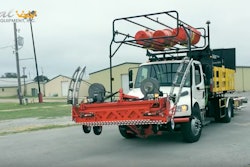 The joint report finds 52 percent of highway workers are younger than 45, a younger group than found in either transit or railroad.
The joint report finds 52 percent of highway workers are younger than 45, a younger group than found in either transit or railroad.A joint transportation jobs report released by the U.S. Departments of Transportation, Labor and Education estimates 388,904 highway construction and maintenance job openings will be created between 2012 and 2022, with the majority being for semi-skilled and highly skilled workers.
The report, “Strengthening Skills Training and Career Pathways across the Transportation Industry,” provides a look at potential growth areas in six subsectors of the U.S. transportation industry, including trucking, transit and ground passenger, air transportation, highway construction and maintenance, rail and maritime.
“Careers in the transportation industry can lift Americans into the middle class or help them stay there, and this report concludes that there will be more job opportunities in the near future,” U.S. Secretary of Transportation Anthony Foxx said. “We want to fill all these new positions, so industry and government must increase recruitment and help young people get the skills, training, and apprenticeships they need to gain entry into these careers.”
For construction and maintenance, the report shows an estimate of 141,009 job openings for highway maintenance worker positions over the 10-year period, representing more than a third of the total estimate for the category.
Construction laborer openings came in second highest at 88,860 openings, or roughly 23 percent of the category total, followed by operating engineers and other construction equipment operators (44,729), heavy and tractor-trailer truck drivers (28,625), first-line supervisors of construction trades and extraction workers (24,756), paving, surfacing and tamping equipment operators (19,903), carpenters (15,609), cement masons and concrete finishers (12,875), construction managers (6,882) and office clerks/general positions (5,656).
The report also includes median annual wages for these jobs. Not surprisingly, construction managers top the list at $87,048, following by first-line supervisors ($62,254), operating engineers and other construction equipment operators ($48,568), carpenters ($44,970), paving, surfacing and tamping equipment operators ($38,189), cement masons and concrete finishers ($37,502), heavy and tractor-trailer truck drivers ($36,005), highway maintenance workers ($34,507), construction laborers ($33,592) and office clerks/general positions ($30,846).
The rate of net job growth is spread across the country, with only 15 states projected to have negative growth. Hawaii stands out with the highest projected growth at 58 percent, followed by Florida and Ohio (42 percent), Washington (39 percent), Colorado and Delaware (34 percent), Minnesota (33 percent), New Jersey (32 percent), Nevada (29 percent) and North Carolina (26 percent) to round out the top 10. The top five states expected to have negative growth include South Carolina (-26 percent), Massachusetts (-22 percent), New Mexico (-18 percent), Wyoming (-14 percent) and Montana (-13 percent).
Looking at the effect of occupational transfer rates (leaving one occupation for another) and labor force exit rates (leaving the labor force completely), the report finds two job categories with a greater than 100 percent rate of total job openings needing to be filled between 2012 and 2022. These include office clerks/general positions at 106.9 percent and heavy and tractor-trailer truck drivers at 101.1 percent. Following not far behind are construction laborers at 95.5 percent, highway maintenance workers (89.6 percent), paving, surfacing and tamping equipment operators (89.4 percent) and operating engineers and other construction equipment operators (87.5 percent).
In the concluding remarks, the report indicates that there is clearly a “critical need for building a qualified and skilled transportation workforce.”
To fill this need, the three departments (Transportation, Labor and Education) plan to coordinate efforts to “align skills training and Career Pathways programs with job demand” via a four pronged approach:
- “Career and technical education programs of study, beginning in high school and continuing into postsecondary education or apprenticeship can provide the foundational and early occupational skills training needed in skilled occupations.”
- “Pre-apprenticeship programs for disadvantaged youth and adults can prepare low- skilled and underrepresented populations for entry into these skilled positions. “
- “Career Pathways systems that are aligned with Registered Apprenticeship programs can expand the number of people who can access these high-demand jobs.”
- “Significant training at the workplace helps people move from novice to skilled practitioner in their craft. “
The full report is available here.











